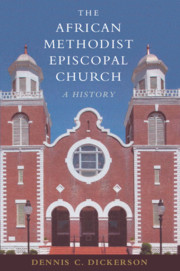Book contents
- The African Methodist Episcopal Church
- The African Methodist Episcopal Church
- Copyright page
- Dedication
- Contents
- Illustrations
- Preface
- Introduction
- 1 Richard Allen and the Rise of African Methodism in the Atlantic World, 1760–1831
- 2 The Freedom Church, 1831–1861
- 3 “Welcome to the Ransomed,” 1861–1880
- 4 A Denomination in the Diaspora, 1880–1916
- 5 Into the Second Century: Migration, Depression, and War, 1916–1945
- 6 Freedom Now! Civil Rights, Black Power, and Anticolonial Insurgencies, 1945–1976
- 7 Becoming a Global Church, 1976–2018
- Epilogue
- Appendix The Bishops of the African Methodist Episcopal Church, 1816–2018
- Bibliography
- Index
7 - Becoming a Global Church, 1976–2018
Published online by Cambridge University Press: 20 December 2019
- The African Methodist Episcopal Church
- The African Methodist Episcopal Church
- Copyright page
- Dedication
- Contents
- Illustrations
- Preface
- Introduction
- 1 Richard Allen and the Rise of African Methodism in the Atlantic World, 1760–1831
- 2 The Freedom Church, 1831–1861
- 3 “Welcome to the Ransomed,” 1861–1880
- 4 A Denomination in the Diaspora, 1880–1916
- 5 Into the Second Century: Migration, Depression, and War, 1916–1945
- 6 Freedom Now! Civil Rights, Black Power, and Anticolonial Insurgencies, 1945–1976
- 7 Becoming a Global Church, 1976–2018
- Epilogue
- Appendix The Bishops of the African Methodist Episcopal Church, 1816–2018
- Bibliography
- Index
Summary
Brazilians in 1996, conscious that African Methodist Episcopal members (AMEs) were attending the World Methodist Conference in Rio de Janeiro, met and entreated them to establish the denomination in this Portuguese speaking country. The 3,647,000 African slaves transported to Brazil during the Atlantic slave trade vastly outnumbered the 399,000 who survived the Middle Passage and landed in what would become the United States. Slavery lasted longer in Brazil, ending in 1888, but dying earlier in the United States, in 1865, because of a civil war. This historical background and a black Brazilian population, estimated at 97 million, framed interactions between Brazilian Methodists and AME Bishops Carolyn Tyler Guidry and Sarah F. Davis who envisaged denominational possibilities in this part of Latin America. Notwithstanding an abortive attempt by the AME Zion Church to spread to Brazil in the 1920s, mainly in black Bahia, several decades passed before some of Brazil’s black Methodists could wrest themselves from the foundational influences of the white Methodist Episcopal Church, South.1
- Type
- Chapter
- Information
- The African Methodist Episcopal ChurchA History, pp. 465 - 545Publisher: Cambridge University PressPrint publication year: 2020

